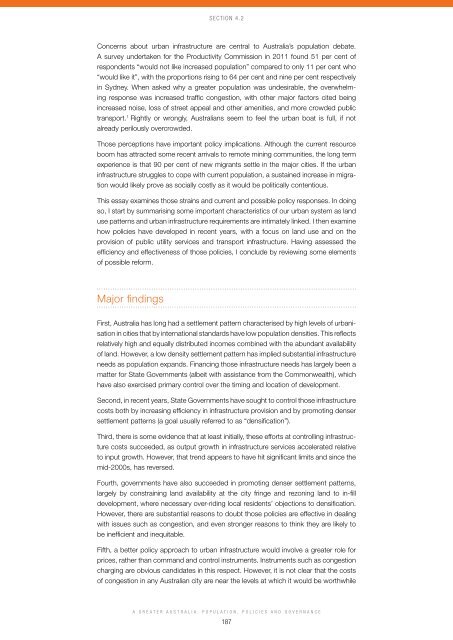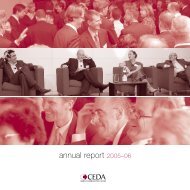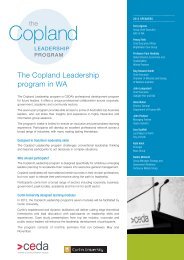Section 4.2Concerns about urban infrastructure are central to <strong>Australia</strong>’s population debate.A survey undertaken for the Productivity Commission in 2011 found 51 per cent ofrespondents “would not like increased population” compared to only 11 per cent who“would like it”, with the proportions rising to 64 per cent <strong>and</strong> nine per cent respectivelyin Sydney. When asked why a greater population was undesirable, the overwhelmingresponse was increased traffic congestion, with other major factors cited beingincreased noise, loss of street appeal <strong>and</strong> other amenities, <strong>and</strong> more crowded publictransport. 1 Rightly or wrongly, <strong>Australia</strong>ns seem to feel the urban boat is full, if notalready perilously overcrowded.Those perceptions have important policy implications. Although the current resourceboom has attracted some recent arrivals to remote mining communities, the long termexperience is that 90 per cent of new migrants settle in the major cities. If the urbaninfrastructure struggles to cope with current population, a sustained increase in migrationwould likely prove as socially costly as it would be politically contentious.This essay examines those strains <strong>and</strong> current <strong>and</strong> possible policy responses. In doingso, I start by summarising some important characteristics of our urban system as l<strong>and</strong>use patterns <strong>and</strong> urban infrastructure requirements are intimately linked. I then examinehow <strong>policies</strong> have developed in recent years, with a focus on l<strong>and</strong> use <strong>and</strong> on theprovision of public utility services <strong>and</strong> transport infrastructure. Having assessed theefficiency <strong>and</strong> effectiveness of those <strong>policies</strong>, I conclude by reviewing some elementsof possible reform.Major findingsFirst, <strong>Australia</strong> has long had a settlement pattern characterised by high levels of urbanisationin cities that by international st<strong>and</strong>ards have low population densities. This reflectsrelatively high <strong>and</strong> equally distributed incomes combined with the abundant availabilityof l<strong>and</strong>. However, a low density settlement pattern has implied substantial infrastructureneeds as population exp<strong>and</strong>s. Financing those infrastructure needs has largely been amatter for State Governments (albeit with assistance from the Commonwealth), whichhave also exercised primary control over the timing <strong>and</strong> location of development.Second, in recent years, State Governments have sought to control those infrastructurecosts both by increasing efficiency in infrastructure provision <strong>and</strong> by promoting densersettlement patterns (a goal usually referred to as “densification”).Third, there is some evidence that at least initially, these efforts at controlling infrastructurecosts succeeded, as output growth in infrastructure services accelerated relativeto input growth. However, that trend appears to have hit significant limits <strong>and</strong> since themid-2000s, has reversed.Fourth, governments have also succeeded in promoting denser settlement patterns,largely by constraining l<strong>and</strong> availability at the city fringe <strong>and</strong> rezoning l<strong>and</strong> to in-filldevelopment, where necessary over-riding local residents’ objections to densification.However, there are substantial reasons to doubt those <strong>policies</strong> are effective in dealingwith issues such as congestion, <strong>and</strong> even stronger reasons to think they are likely tobe inefficient <strong>and</strong> inequitable.Fifth, a better policy approach to urban infrastructure would involve a greater role forprices, rather than comm<strong>and</strong> <strong>and</strong> control instruments. Instruments such as congestioncharging are obvious c<strong>and</strong>idates in this respect. However, it is not clear that the costsof congestion in any <strong>Australia</strong>n city are near the levels at which it would be worthwhileA <strong>Greater</strong> <strong>Australia</strong>: <strong>Population</strong>, Policies <strong>and</strong> Governance187
Section 4.2bearing the fixed costs congestion charging involves. Moreover, it is a mistake to thinkcongestion charging would resolve the concerns existing residents could properly haveabout increased population: unless the income from the charges was recycled to thoseexisting users, they would still likely be worse off, <strong>and</strong> almost certainly so as a group.Sixth, better price signals also have an important role to play in l<strong>and</strong> use decisions.It makes little sense to prevent fringe development if potential residents are willing tobear the full costs it involves. But for informed decisions to be made in that respect,decision-makers must face those costs. Equally, it does not make sense to force localcommunities to accept densification when the costs it imposes exceed the benefits.However, at the moment local communities bear a far larger share of the costs densificationimposes, than they garner of the benefits, giving them incentives to be undulyrestrictive. This, in turn, provides an excuse for State Governments to limit the role localcommunities play in l<strong>and</strong> use decisions. A better response would be to decentraliselocal taxing, spending <strong>and</strong> settlement decisions to local councils, as that would improvethe incentives local residents faced, encouraging them to approve development whereits benefits exceed its costs, <strong>and</strong> oppose it otherwise.The <strong>Australia</strong>n settlement systemTo underst<strong>and</strong> the pressures on <strong>Australia</strong>’s urban infrastructure, it is useful to start witheight salient features of our population geography.First, from the earliest days of European settlement, <strong>Australia</strong> was a highly urbanisedsociety <strong>and</strong> that urban focus has persisted to the present day. By 1911, the capitalcities accounted for nearly 40 per cent of the population, with that proportion rising toover 60 per cent in 1961 <strong>and</strong> to around 65 per cent since then.Second, although secondary cities have long been important in New South Wales<strong>and</strong> Queensl<strong>and</strong>, the capital city has been dominant in all states <strong>and</strong> that dominancehas become more pronounced, thanks partly to the decline in specialised centres ofheavy industry such as Wollongong, Whyalla <strong>and</strong> the Latrobe Valley. Thus, areas ofrapid urban growth in recent years, for instance, the Gold Coast in Queensl<strong>and</strong> <strong>and</strong>the Hunter in New South Wales, have been, or have tended to become, part of greaterconurbations centred on the capital city.Third, the other side of this metropolitan dominance is the stability of the urban hierarchy,so that while the relativities between the capitals have changed, there has not beensignificant entry or exit into the hierarchy of larger cities since the formation of Canberra(which was a political decision, rather than the result of economic processes). To thatextent, the barriers to the emergence of competing urban centres seem high, at leastcompared to the United States, despite relatively high population mobility. Competitionhas therefore been largely between incumbent cities.Fourth, a consequence of the dominance of the capital city is that from the outset, <strong>governance</strong>of the major urban areas has been fairly tightly controlled by State Governmentsrather than vested in genuinely independent local bodies. All states delegate a rangeof taxing <strong>and</strong> spending functions to local governments, but even those functions aretypically subject to substantial oversight <strong>and</strong> control by State Governments, especiallyas they bear on the capital city. As well as tending to entrench the capital city’s dominance,this results in a complex structure of metropolitan <strong>governance</strong>, with blurred,frequently changing <strong>and</strong> often overlapping responsibilities between <strong>and</strong> within state<strong>and</strong> local bodies. 2A <strong>Greater</strong> <strong>Australia</strong>: <strong>Population</strong>, Policies <strong>and</strong> Governance188
- Page 2 and 3:
A Greater Australia:Population, pol
- Page 4 and 5:
ContentsForeword CEDA Chief Executi
- Page 6 and 7:
ForewordIt is with pleasure that I
- Page 8 and 9:
IntroductionResponding to the resul
- Page 10 and 11:
IntroductionA more dynamic and vita
- Page 12 and 13:
IntroductionSustainabilityConcern a
- Page 14 and 15:
IntroductionThe new demographics, h
- Page 16 and 17:
Section 1.0Historical perspectives1
- Page 18 and 19:
Section 1.1IntroductionJapan’s cr
- Page 20 and 21:
Section 1.1Figure 1Forecast number
- Page 22 and 23:
Section 1.1Table 1Defence spending
- Page 24 and 25:
Section 1.1How much defence is enou
- Page 26 and 27:
Section 1.1ConclusionA substantial
- Page 28 and 29:
Section 1.2There has been over a ce
- Page 30 and 31:
Section 1.2Resource constraints wer
- Page 32 and 33:
Section 1.2Similarly, in the 1994 H
- Page 34 and 35:
Section 1.2ReferencesAustralia, Dep
- Page 36 and 37:
Section 1.3IntroductionAustralia is
- Page 38 and 39:
Section 1.3The grey 90sThe heady ex
- Page 40 and 41:
Section 1.3Taylor’s stony rebutta
- Page 42 and 43:
Section 1.3Figure 1The Benhamite Op
- Page 44 and 45:
Section 1.3In mathematical terms, t
- Page 46 and 47:
Section 1.3characterisation of the
- Page 48 and 49:
Section 1.3ConclusionA retrospectiv
- Page 50 and 51:
Section 2.0Population futures2.1 Fo
- Page 52 and 53:
Section 2.1Conventional population
- Page 54 and 55:
Section 2.1It is more useful for go
- Page 56 and 57:
Section 2.1Forecasting of births, w
- Page 58 and 59:
Section 2.1Future net overseas migr
- Page 60 and 61:
Section 2.13). This had a lot to do
- Page 62 and 63:
Section 2.2IntroductionIn late Sept
- Page 64 and 65:
Section 2.2Figure 1The migrant cont
- Page 66 and 67:
Section 2.2The visa and residency s
- Page 68 and 69:
Section 2.2sponsorship, subject to
- Page 70 and 71:
Section 2.2Figure 3Historical and p
- Page 72 and 73:
Section 2.2The views in this chapte
- Page 74 and 75:
Section 2.3IntroductionThe Australi
- Page 76 and 77:
Section 2.3Figure 3Australia: Distr
- Page 78 and 79:
Section 2.3Table 2Australia: Popula
- Page 80 and 81:
Section 2.3Table 4Views of Australi
- Page 82 and 83:
Section 2.3Table 5Australian States
- Page 84 and 85:
Section 2.3A number of hypotheses h
- Page 86 and 87:
Section 2.3Table 8Australia: Distri
- Page 88 and 89:
Section 2.3Table 10Non-Metropolitan
- Page 90 and 91:
Section 2.3Policy issuesThe configu
- Page 92 and 93:
Section 2.3Climate change is likely
- Page 94 and 95:
Section 2.3ConclusionAny realistic
- Page 96 and 97:
Section 2.340 Swan, W., 2010.Austra
- Page 98 and 99:
Section 2.4IntroductionThe Australi
- Page 100 and 101:
Section 2.4At present there is a hi
- Page 102 and 103:
Section 2.4innovation initiatives w
- Page 104 and 105:
Section 2.4Endnotes1 Henry, K 2009,
- Page 106 and 107:
Section 2.5IntroductionAustralia is
- Page 108 and 109:
Section 2.5else. Even with a broad
- Page 110 and 111:
Section 2.5commercially viable - th
- Page 112 and 113:
Section 2.5A vast country like Aust
- Page 114 and 115:
Section 3.0Society and the individu
- Page 116 and 117:
Section 3.1Extent of public opinion
- Page 119 and 120:
Section 3.1category immigrant/forei
- Page 121 and 122:
Section 3.1The Environics Research
- Page 123 and 124:
Section 3.1Per cent100908070Figure
- Page 125 and 126:
Section 3.1A number of surveys soug
- Page 127 and 128:
Section 3.1Table 8Percentage who an
- Page 129 and 130:
Section 3.1A more precise indicatio
- Page 131 and 132:
Section 3.1The strongest predictor
- Page 133 and 134:
Section 3.1Endnotes1. There is also
- Page 135 and 136:
3.2Social inclusion and multicultur
- Page 137 and 138: Section 3.2a broader definition of
- Page 139 and 140: Section 3.2Figure 1Estimated povert
- Page 141 and 142: Section 3.2Table 2Visa Type of Sett
- Page 143 and 144: Section 3.2Table 5First Generation
- Page 145 and 146: Section 3.2Table 6Australia: First
- Page 147 and 148: Section 3.2Improving outcomes for v
- Page 149 and 150: Section 3.2increasing diversity of
- Page 151 and 152: 3.3Linkages between education and p
- Page 153 and 154: Section 3.3Education and productivi
- Page 155 and 156: Section 3.3In the past decade, prod
- Page 157 and 158: Section 3.3succeed in education or
- Page 159 and 160: Section 3.3case, funding also could
- Page 161 and 162: Section 3.3Endnotes1 IGR 2010: Chal
- Page 163 and 164: 3.4Healthcare delivery for our agei
- Page 165 and 166: Section 3.4• Private medical serv
- Page 167 and 168: Section 3.4the whole spectrum of in
- Page 169 and 170: Section 3.45. Experiences, pathways
- Page 171 and 172: Section 3.4Stratification of patien
- Page 173 and 174: Section 3.4Other steps include impr
- Page 175 and 176: Section 3.438 National Health Refor
- Page 177 and 178: 4.1The economic effects ofpopulatio
- Page 179 and 180: Section 4.1population growth can ex
- Page 181 and 182: Section 4.1In theory, the answer pa
- Page 183 and 184: Section 4.1Kirchner concedes that t
- Page 185 and 186: Section 4.1Endnotes1. Productivity
- Page 187: 4.2Urban infrastructure and land us
- Page 191 and 192: Section 4.2Figure 1Indicative dwell
- Page 193 and 194: Section 4.2Taking the electricity,
- Page 195 and 196: Section 4.2Promoting better land us
- Page 197 and 198: Section 4.2preferences to homeowner
- Page 199 and 200: Section 4.2in any Australian urban
- Page 201 and 202: Section 4.2Endnotes1 Productivity C
- Page 203 and 204: 4.3Water security:Water for the far
- Page 205 and 206: Section 4.3Water trading enables us
- Page 207 and 208: Section 4.3cent of water entitlemen
- Page 209 and 210: Section 4.3were either the full eco
- Page 211 and 212: Section 4.3Strategic opportunitiesA
- Page 213 and 214: 4.4Critiquing governmentregional de
- Page 215 and 216: Section 4.4However, there is often
- Page 217 and 218: Section 4.4Potential policy interve
- Page 219 and 220: Section 4.4Unfortunately, advocacy
- Page 221 and 222: Section 4.4contribute substantially
- Page 223 and 224: Section 4.418 Department of Educati
- Page 225 and 226: 5.1The future of population policyG
- Page 227 and 228: Section 5.1a million fewer women in
- Page 229 and 230: Section 5.1For the present, ongoing
- Page 231 and 232: Section 5.1The second worry is that
- Page 233 and 234: Section 5.1The now significantly de





